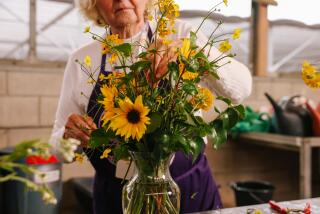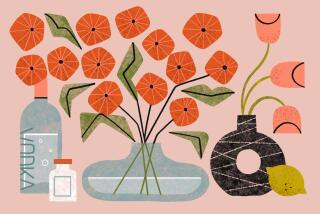GARDENING : Seeing Bulbs in a New Light : No cold needed. Plants from Mediterranean or South Africa warm to the local climate.
- Share via
Poets haven’t waxed lyrical about anemones and ixia the way they have some other bulb flowers, but for this climate, they’re a better addition to the garden.
A visit to a local nursery now can tempt you with bushel baskets filled with plump bulbs and colorful photos of bright tulips and golden daffodils.
There’s a tendency to pass by the odd-shaped “bulbs” with unfamiliar names such as anemone, ixia, sparaxis, tritonia and watsonia. Yet these plants can thrive year after year and produce an abundance of flowers.
Tulips, daffodils, crocuses and hyacinths prefer cold climates. They need artificial chilling to force them into dormancy so they can bloom here. They can be grown only as annuals.
But the bulbs and bulb-like plants that hail from Mediterranean or South African climates thrive in the similar climate of Orange County. With the exception of narcissi and a very few strains of daffodils developed for warm climates, most bulbs last only one season here, because it just isn’t cold enough here to give them the dormant period they need.
Not so with the bulbs, corms and rhizomes plants that hail from climates similar to ours.
Take watsonia. Originally native to South Africa, there are now more than 70 species and hybrids. Grown from corms, they thrive in our region and produce tall flower spikes in fall or winter, when color is often sparse in the garden. It’s excellent for naturalizing.
Watsonia is best planted in the middle or rear of a garden bed, because it reaches a height of four or five feet, with an equal spread. Several dwarf varieties were introduced recently, and they grow to a more demure height of two feet. Watsonia is available in white, orange, pink, rubra (reddish-pink), deep red and lavender.
Anemones stay in bloom in the garden for up to two months and hold up well as cut flowers for bouquets. However, many people tend to pass on planting anemones because the bulbs look like strange little rocks. It’s almost impossible to detect stem from root section, so, when planting, place them sideways. Anemones prefer full sun but will also bloom when planted with afternoon sun or filtered light. Removing spent flowers (dead heading) will encourage the plants to produce more blooms.
Another good choice for this area is ranunculus. These tubers can repeat in future years if the soil has excellent drainage so the tubers don’t rot away. Large tubers of these showy plants will produce abundant blooms throughout spring. Color selection ranges from white to orange, yellow, red, pink and picotee blends.
Select the largest tubers available and plant two inches deep, with the clawlike part of the tuber pointing down into the soil. Be sure soil is well worked and quick-draining. Water when first planting, then wait until green growth appears above the soil before watering again, about two weeks. If the Santa Anas begin to blow and the soil becomes very dry, water sooner.
Dan Davids, president of Davids and Royston Bulb Co., the West’s largest wholesale supplier of bulbs, recommends freesias for fragrance, watsonia for height and tritonia for strong color in the garden and for cut flowers.
“We introduced tritonia to the market just four years ago, and they’re really catching on,” he said. “The strong solid colors and rigid stems make tritonia an excellent choice for bouquets and gardens.”
Davids also recommends amaryllis, scilla and sparaxis as excellent choices for our warm climate.
In his opinion, if the right bulbs are chosen and a few basic preparations made, they’re easy to grow in the garden or in containers.
With the right selection, you can expect to see your bulbs multiply in the garden for years to come, although Davids cautions that the term “naturalizing” in our climate really means a period of four or five years, because the soils in this region are contaminated.
“We have dirty soils that contain disease and viruses carried by aphids,” Davids explained. “The problem is we over-water and over-fertilize, and this promotes disease.”
Bulb Planting Tips
Containers
Many bulbs can be grown successfully in pots. Select a good quality planting mix and place a handful of bulb fertilizer near the bottom. Add enough bulbs to create an attractive mass effect, and cover with planting mix. Water thoroughly and place in a sunny location. Water as planting mix dries out.
Once bulbs have finished blooming, withhold water and let the stems and leaves yellow and die. You may want to put the pots in a garage or basement while the plants are going through their natural decline and dormancy cycle. It’s important to let the leaves yellow because this is how the plants store nutrients in the bulbs, corms or rhizomes for next year’s bloom cycle.
Some bulbs can be forced into early bloom indoors where the temperatures are warm. Amaryllis and hyacinth will bloom in December or January indoors, months earlier than in the garden.
Gardens
Select sunny locations, work the soil and mix in sand or organic amendment to promote good drainage if the soil is heavy clay. Mix bulb fertilizer in the soil if you’re planting large quantities, insert bulbs to the depth recommended for the particular variety, and cover. Water only as needed. If only a few bulbs are planted, place a handful of bulb fertilizer at the bottom of each planting hole.
Allow foliage to yellow and die back naturally. To camouflage the dying foliage, some gardeners braid the stems, roll them up and plant other plants nearby.
Recommended Plants
Anemone. These poppy-shaped flowers come in many colors. Excellent for garden or bouquets.
Freesia. Highly fragrant. Hybrids vary in height from one to two feet; tubular flowers in colors including lavender, purple or blue.
Ixia. Easy to grow from corms; 18-inch flower spikes produced in May and June in colors ranging from white to yellow, orange, red, rose pink.
Scilla peruviana. Bulbs native to the Mediterranean region, they grow well in full sun or bright filtered light. Clusters of bluish-purple flowers emerge on one-foot stalks in May or June.
Sparaxis. Called the Harlequin Flower because the vividly colored blossoms are often blotched with contrasting colors. Plant corms in full sun, near the front of the border or bed. Plants reach a height of about one foot.
Tritonia. Closely related to freesia and ixia. Plant corms in full sun. Flowers are orange, red, salmon, yellow or apricot and are produced in spike-like clusters on rigid stems. Excellent cut flower.
Watsonia. Plant corms in full sun. Flowers produced on spikes like gladiolus, but smaller. Over several years, they form large clumps that die down in summer.
Zantedeschia (calla). Rhizomatous plants native to South Africa. The most common form is white. Newer hybrids are spotted, pastel, green or golden. Most thrive in spots that receive heavy water.






